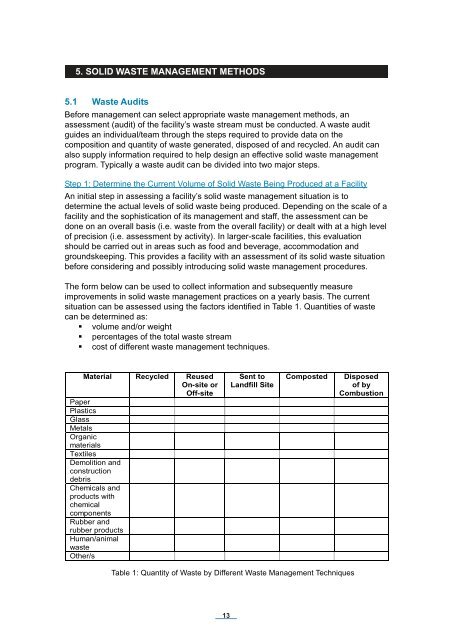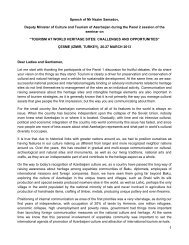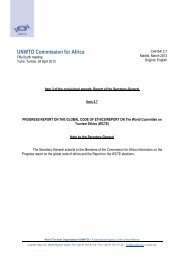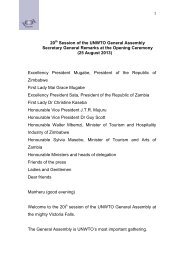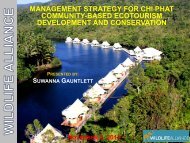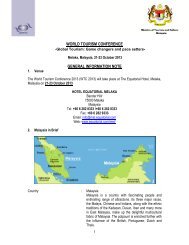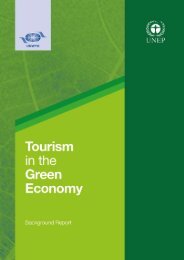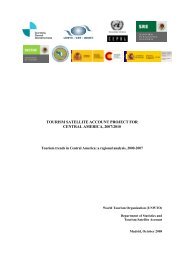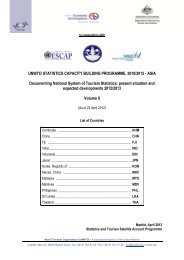A Manual for Water and Waste Management - World Tourism ...
A Manual for Water and Waste Management - World Tourism ...
A Manual for Water and Waste Management - World Tourism ...
You also want an ePaper? Increase the reach of your titles
YUMPU automatically turns print PDFs into web optimized ePapers that Google loves.
5. SOLID WASTE MANAGEMENT METHODS<br />
5.1 <strong>Waste</strong> Audits<br />
Be<strong>for</strong>e management can select appropriate waste management methods, an<br />
assessment (audit) of the facility’s waste stream must be conducted. A waste audit<br />
guides an individual/team through the steps required to provide data on the<br />
composition <strong>and</strong> quantity of waste generated, disposed of <strong>and</strong> recycled. An audit can<br />
also supply in<strong>for</strong>mation required to help design an effective solid waste management<br />
program. Typically a waste audit can be divided into two major steps.<br />
Step 1: Determine the Current Volume of Solid <strong>Waste</strong> Being Produced at a Facility<br />
An initial step in assessing a facility’s solid waste management situation is to<br />
determine the actual levels of solid waste being produced. Depending on the scale of a<br />
facility <strong>and</strong> the sophistication of its management <strong>and</strong> staff, the assessment can be<br />
done on an overall basis (i.e. waste from the overall facility) or dealt with at a high level<br />
of precision (i.e. assessment by activity). In larger-scale facilities, this evaluation<br />
should be carried out in areas such as food <strong>and</strong> beverage, accommodation <strong>and</strong><br />
groundskeeping. This provides a facility with an assessment of its solid waste situation<br />
be<strong>for</strong>e considering <strong>and</strong> possibly introducing solid waste management procedures.<br />
The <strong>for</strong>m below can be used to collect in<strong>for</strong>mation <strong>and</strong> subsequently measure<br />
improvements in solid waste management practices on a yearly basis. The current<br />
situation can be assessed using the factors identified in Table 1. Quantities of waste<br />
can be determined as:<br />
volume <strong>and</strong>/or weight<br />
percentages of the total waste stream<br />
cost of different waste management techniques.<br />
Material Recycled Reused<br />
On-site or<br />
Paper<br />
Plastics<br />
Glass<br />
Metals<br />
Organic<br />
materials<br />
Textiles<br />
Demolition <strong>and</strong><br />
construction<br />
debris<br />
Chemicals <strong>and</strong><br />
products with<br />
chemical<br />
components<br />
Rubber <strong>and</strong><br />
rubber products<br />
Human/animal<br />
waste<br />
Other/s<br />
Off-site<br />
Table 1: Quantity of <strong>Waste</strong> by Different <strong>Waste</strong> <strong>Management</strong> Techniques<br />
13<br />
Sent to<br />
L<strong>and</strong>fill Site<br />
Composted Disposed<br />
of by<br />
Combustion


